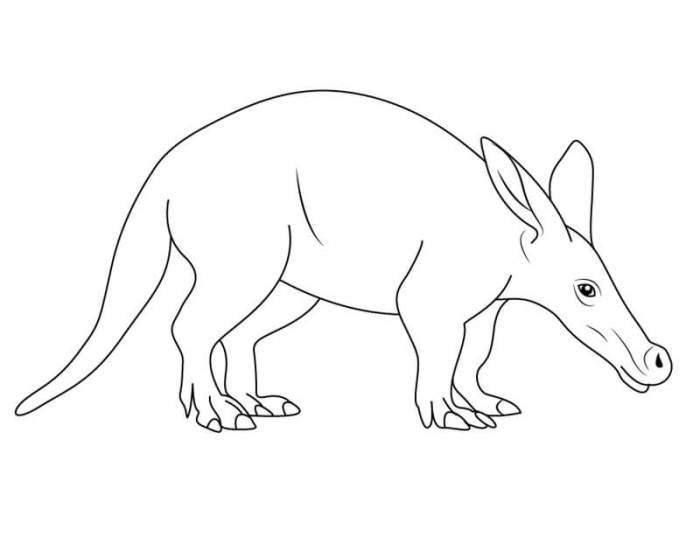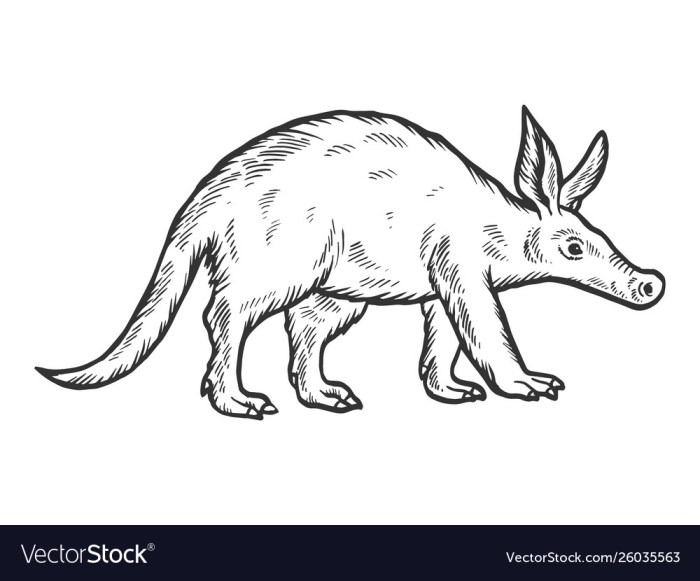Understanding Aardvark Anatomy for Simplified Drawing

Easy drawing of a aardvark – Drawing an aardvark, while seemingly complex, becomes surprisingly manageable when you break down its anatomy into simpler shapes. By focusing on key proportions and characteristic features, even beginners can create a recognizable and pleasing depiction. This guide simplifies the process, offering a step-by-step approach to capturing the essence of this unique mammal.
Basic Body Shape and Proportions
The aardvark’s body is essentially a long, slightly tapered cylinder. Think of it as a sausage with legs. The length from the snout to the base of the tail is roughly three times the height at the shoulder. The tail is relatively thick and about half the length of the body. To simplify, start with a long oval for the body, then refine it by gently tapering the rear end.
Head Characteristics
The aardvark’s head is distinctive, featuring a long, tubular snout, large ears, and small, relatively inconspicuous eyes. The snout is crucial; it’s roughly one-third the length of the head and tapers to a rounded point. The ears are large and pointed, almost like triangles attached to the sides of the head. The eyes are small and round, positioned relatively close to the snout.
To simplify, draw the head as an elongated triangle with rounded edges, then add the snout as a smaller, attached triangle, and the ears as simple, slightly curved triangles. Position the eyes as small dots near the base of the snout.
Leg and Foot Structure
Aardvarks possess sturdy legs, relatively short in proportion to their body length. Their feet are characterized by strong claws, ideal for digging. The legs are somewhat columnar, slightly tapering towards the feet. The feet themselves are small, with four toes on the front feet and five on the hind feet, each tipped with a powerful claw. For a simplified drawing, represent the legs as simple, slightly curved cylinders, and the feet as small, oval shapes with pointed claws indicated by short, curved lines.
Avoid excessive detail; focus on the overall shape and position.
Simplified Drawing Steps
1. Start with the basic body shape
Begin with a long oval for the body, tapering slightly towards the tail.
2. Add the head
Attach an elongated triangle for the head, adding the snout and ears as described earlier. Don’t forget the small eyes.
3. Draw the legs
Add four short, slightly curved cylinders for the legs, positioning them beneath the body.
4. Add the feet
Attach small oval shapes to the ends of the legs, representing the feet. Add a few short lines to indicate the claws.
5. Refine the details
Gently round off sharp edges and add subtle curves to make the drawing more natural-looking. Consider adding a simple, slightly curved line to represent the tail. Avoid over-detailing; the aim is simplicity and clarity.
Easy Drawing Techniques for Beginners

Drawing an aardvark, even for beginners, can be a fun and rewarding experience. By breaking down the process into simple steps and utilizing basic shapes, anyone can create a recognizable and charming aardvark drawing. This section focuses on easy techniques to achieve a successful aardvark sketch.
Constructing the Aardvark with Basic Shapes
Begin by sketching a large oval for the aardvark’s body. Attach a smaller, slightly elongated oval to one end for the head. A long, thin rectangle extending from the body represents the aardvark’s snout. Add two small circles for the ears, positioned on top of the head. Use smaller ovals for the legs, and remember that aardvark legs are relatively short and stout.
Finally, add small circles for the feet. This basic shape framework provides a solid foundation for refining your aardvark drawing. Remember to keep your initial sketches light; you can easily erase and adjust as needed.
Mastering the art of drawing an aardvark begins with understanding its unique anatomy: long snout, powerful claws. For a similar level of simplified representation, consider the straightforward shapes found in coloring pages simple easy soldier drawing ; these exercises build foundational skills applicable to any creature, including our endearing, insectivorous aardvark. Returning to our aardvark, remember to emphasize its characteristic tubular body and robust legs.
Simplifying Aardvark Fur Texture
Aardvarks have short, sparse fur. Instead of attempting to draw each individual hair, focus on suggesting texture through subtle shading and line variations. Use short, light strokes to create a slightly rough texture on the body, particularly along the back and sides. The fur is less noticeable on the snout and legs, so use smoother lines in these areas to contrast with the body.
This simplified approach avoids unnecessary detail and keeps the drawing clean and approachable.
Adding Shading for Depth
Shading is crucial for giving your aardvark drawing depth and volume. Start by identifying the light source. Let’s assume the light is coming from the upper left. Use a darker pencil shade on the opposite side of the body (lower right) to indicate shadow. Gradually lighten the shading as you move towards the light source.
Pay close attention to the curves of the body to create a sense of three-dimensionality. Don’t be afraid to experiment with different shading techniques, like hatching or cross-hatching, to create variations in tone. Remember, the goal is to suggest form, not to create photorealistic detail.
Utilizing Pencil Techniques for Contrast and Texture
Different pencil techniques can significantly enhance your aardvark drawing. Use lighter pencil strokes for areas that receive direct light, such as the top of the head and the front of the body. For shadowed areas, use darker strokes and vary the pressure to create a range of tones. For example, you might use light hatching on the ears to show their texture, and heavier cross-hatching in the shadow under the aardvark’s chin to create contrast and emphasize the form.
Experiment with blending techniques to soften transitions between light and shadow, adding depth and realism to your artwork. Remember to keep your pencil strokes consistent with the overall style of your drawing.
Illustrating Aardvarks in Different Poses: Easy Drawing Of A Aardvark

Aardvarks, with their unique physique and endearingly awkward gait, offer a delightful challenge for artists. Capturing their essence requires understanding their anatomy and how their body moves in different situations. This section will explore three common poses: standing, digging, and walking, providing a step-by-step guide to help you bring these fascinating creatures to life on paper.
Aardvark Poses: Key Features, Easy drawing of a aardvark
Understanding the key features of each pose is crucial for creating a believable and dynamic illustration. These features guide the positioning of limbs, the angle of the body, and the overall impression of the aardvark’s action.
- Standing: The aardvark stands with its legs positioned directly beneath its body, maintaining a relatively straight posture. Its long snout points slightly downward, and its ears are generally upright and alert. The tail hangs down, providing counterbalance.
- Digging: The digging pose showcases the aardvark’s powerful forelimbs and claws. Its front legs are bent and positioned forward, with the claws digging into the ground. The body is lowered, with the hind legs providing support and leverage. The snout is often pointed towards the ground.
- Walking: The walking pose demonstrates the aardvark’s characteristic gait. Its legs move in a diagonal sequence, with the front and rear legs on opposite sides moving together. The body maintains a relatively horizontal posture, with a slight sway as it moves.
Drawing an Aardvark Digging
This step-by-step guide focuses on drawing an aardvark in a digging pose, emphasizing the perspective and limb positions.
- Sketch the basic shape: Start with a rough sketch of the aardvark’s body, suggesting a slightly elongated, curved shape, lowered towards the ground. Imagine a slightly flattened teardrop shape.
- Add the legs: Draw the front legs bent at the elbows, with the paws deeply embedded in the ground. The hind legs should be positioned slightly behind, providing support. Note the powerful muscles in the forelimbs.
- Define the head and snout: Draw the long, tubular snout pointing downwards towards the ground. Add the characteristic long ears, slightly angled forward.
- Add details: Refine the body shape, adding details like the tail and the coarse texture of the aardvark’s fur. Pay attention to the musculature of the legs and the position of the claws.
- Refine and shade: Erase unnecessary lines, refine the proportions, and add shading to create depth and volume. Focus on the shadows created by the aardvark’s body and the ground.
Drawing an Aardvark Walking
Illustrating an aardvark walking requires careful attention to the movement of the legs and body. The sequence of leg movement is crucial to capturing a natural gait.
- Start with the body: Begin by sketching a slightly elongated oval for the body, tilted slightly forward to suggest movement.
- Add the legs: Draw the legs in a diagonal sequence. One front leg and the opposite hind leg should be extended forward, while the other two legs are positioned more towards the rear, bent at the knees and elbows.
- Add the head and snout: Draw the elongated snout, slightly lowered and pointing forward. Add the ears, which may be slightly angled depending on the direction of movement.
- Refine and add details: Refine the shape of the body and legs, adding details like the tail and the texture of the fur. Consider adding a slight blur or motion lines to suggest movement.
- Add shading and finish: Add shading to enhance the three-dimensionality of the aardvark and emphasize the movement. Erase unnecessary lines and refine the details for a polished finish.
Step-by-Step Guide Comparison
| Standing | Digging | Walking |
|---|---|---|
| 1. Basic oval shape 2. Add legs directly beneath body 3. Long snout, upright ears 4. Add tail 5. Refine and shade |
1. Flattened teardrop shape 2. Bent front legs, paws in ground 3. Snout pointing down 4. Add details, claws 5. Refine and shade |
1. Elongated oval, tilted forward 2. Diagonal leg sequence 3. Snout forward, ears angled 4. Add details, motion lines 5. Refine and shade |
Common Queries
What kind of pencils are best for drawing aardvarks?
A variety is helpful! Start with a HB for sketching, then use a 2B or 4B for shading and darker areas. Experiment to find your preference.
How do I make my aardvark drawing look more realistic?
Focus on shading to create depth and form. Observe real aardvark photos to understand how light and shadow play on their bodies.
What if my aardvark drawing doesn’t look perfect?
That’s perfectly okay! Art is a process, and imperfections add character. Keep practicing and have fun with it!
Can I use other materials besides pencils?
Absolutely! Charcoal, pastels, or even colored pencils can create beautiful aardvark drawings. Experiment and see what you like best!

